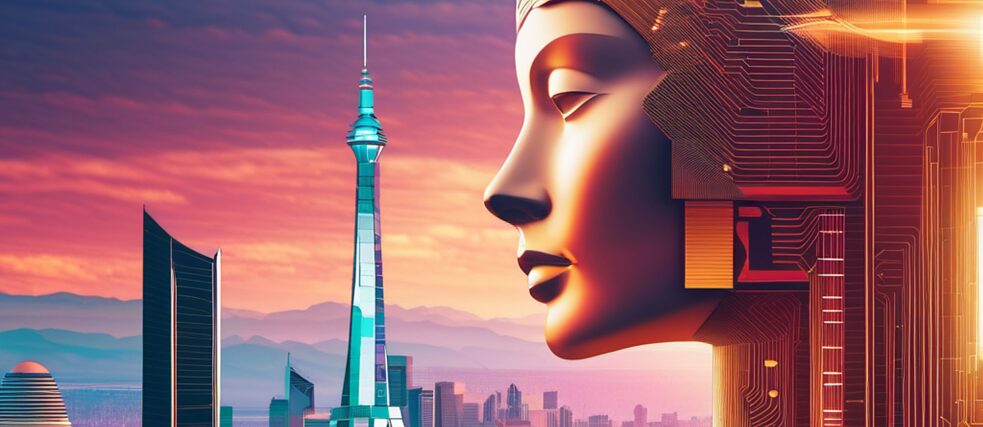Artificial Intelligence
The Shifting Landscape of the Creative Visual Industry in Indonesia

Generative artificial intelligence (AI) technology is making its mark on Indonesia's creative and visual arts industry. Its innovative capabilities are undeniably appealing to users. However, the technology also raises controversies and challenges, particularly regarding its impact on jobs and professional roles. Academics and researchers have been addressing this concern, seeking solutions. One such response, which is currently under experimentation in Yogyakarta, is to ensure Universal Basic Income (UBI) for workers as a way to address its impact on the job market.
Renatta Moeloek, a renowned chef and judge on Master Chef Indonesia, recently starred in an advertising campaign for a prominent bank, touted as the "first campaign to employ generative AI."
In this one-minute advertisement, Renatta assumes multiple professions. In addition to her familiar persona as a chef, she also plays an architect, K-pop idol, and nature photographer. Renatta's “presence” in the advertisement is shown only through photographic works generated by AI. Assembled in an audio-visual production, the technologically-generated images make Renatta appear in settings and engage in activities pertinent to each profession.
The creative mind behind the advertisement is Sim F, director of Susi Susanti: Love All (2019), his first feature film. In an interview, Sim revealed that he started exploring various generative AI apps in mid-2022. Initially, he used the apps to help create mood boards, where an amalgamation of images served as a reference for visual design concepts for film productions he was working on. He then received an offer to produce an advertisement using AI. Sim admitted he was “nervous” in an Instagram post. His initial apprehension was due to generative AI’s tendency to produce inconsistent images, which he felt would become more apparent when used for the purposes of audio-visual storytelling. In spite of this, and with the combined willingness of both the client and the creator to experiment, he was able to use the cutting-edge technology to create an advertisement now considered a masterpiece.
Generative AI’s “Other Side”
The advancement of generative AI technology for creating visual content also has a flip side. As it inherently involves "manipulating" images, there is a potential for its application in a manner where distinguishing what is considered "factual" becomes a challenge.One such example is seen in a widely shared video on TikTok. In this video, an AI-generated male figure claims to be a renowned instant noodle entrepreneur. The video, viewed by millions, involves a story of rivalry between two competing instant noodle brands that currently dominate the Indonesian market.
As far as the narrative itself is considered, some of it may be factual – The story of the brand’s initial collaboration, subsequent separation, and the ensuing legal dispute, culminating in a 2005 Supreme Court ruling, is well-documented and supported by several credible internet sources. However, what raises concern is that the man in the video – through his likeness, movements, gestures, and voice – doesn’t seem to actually be the figure he's claimed to be.
In response to the resulting public attention, the company representing one of the instant noodle brands issued a press release regarding the video. According to an article on detik.com by Oswaldo (2023), the press release stated the man portrayed as the instant executive in the video had neither authorised nor been involved in the creation, distribution, or narration of the video. He also hadn’t been interviewed by the content creators or news outlets. Furthermore, the company stated that it would not respond to any reports or content related to the matter. The release also mentioned the possibility of legal action against parties disseminating such information, with the company reserving its legal right to pursue action against those responsible for creating news and content.
In another context, reporting on kompas.id, Rinaldi (2020) discusses the use of deepfake technology, where individuals are depicted in audio-visual content doing things they never did or saying things they never said – thus grabbing the attention of society, for better or for worse. According to the Organization for Social Media Safety (2003), the first instances of deepfake technology emerged in November 2017 when an anonymous user on the social media platform Reddit uploaded an existing AI algorithm that had been further developed to create realistic fake videos. Other users then shared this programming code on the GitHub platform, and subsequently, apps simplifying the programming process, such as FakeApp, emerged.
Thus far, the presence of deepfakes in widely-circulated audio-visual content is not common in Indonesia. However, as reported by Hardiantoro and Hardiyanto (2023) on kompas.com, there was a recent instance of an imitation of President Joko Widodo's voice singing a song titled Asmalibrasi on TikTok, which garnered millions of views. This has raised concerns among those who fear its potential for political defamation and spreading false information.
The risks associated with generative AI could worsen as deepfake technology advances. It’s not inconceivable that it could be misused by those vying for political power in Indonesia.
As AI technology in the creative industry continues to advance, distinguishing between human and AI-generated works is likely to become challenging. Professionals like Sim, accustomed to viewing visual works produced by both AI and humans, can discern the differences relatively easily. Through pattern recognition, his eyes are more attuned to picking up on irregularities.
However, this is not the case for the majority of people. This would only exacerbate the growing threat of misinformation for most Indonesians. To address this issue, Sim urges individuals to become tech-savvy to better navigate the threats and negative consequences of the technology.
The Future Role of Humans
Even as they embrace the new technology in their advertising productions, there is a certain degree of scepticism when it comes to actually "celebrating" generative AI technology. Sim said that the possibility of people being replaced in jobs in the creative and visual industry is indeed a concern for him.He also pointed out the recent work strikes by scriptwriters and actors' unions in Hollywood. As reported by Murray & Marcus (2023) in The Independent, these strikes were primarily driven by eroding incomes at video streaming companies, along with the emergence of generative AI technology that might "resurrect" deceased actors. This includes claims that studios will scan actors once and use the scans for any number of subsequent productions. In response, studios say that AI scanning would only used for productions that have already employed an actor.
According to Sim, all parties need to be aware while responding to generative AI technology in the creative and visual industry in Indonesia. He emphasises the need for government regulations to ensure the sustainability of human resources in the creative and visual industry.
"AI, which is meant to assist humans, should not erase humans in the process," says Sim.
Sim reminds us that humans cannot turn a blind eye to technological advancements. Humans must improve and develop themselves while harnessing AI to meet creative needs.
 Visual artwork created using generative AI technology on the Stable Diffusion XL platform (https://www.stablediffusionai.ai/) with the prompt "The Role of Humans in the Age of AI." Generated on Monday, 11 September 2023. | © Ingki Rinaldi for Goethe-Institut Indonesia
Visual artwork created using generative AI technology on the Stable Diffusion XL platform (https://www.stablediffusionai.ai/) with the prompt "The Role of Humans in the Age of AI." Generated on Monday, 11 September 2023. | © Ingki Rinaldi for Goethe-Institut Indonesia
"It requires further discussion. Perhaps we could also invite creators from the visual arts industry to share their experiences," suggested Yulia.
Founder of Studio @siapgerak, Herik Fandri, added that the highly dynamic creative industry still relies greatly on human creativity and is far from being driven entirely by AI technology. At the same time, Herik, who is also a motion graphics designer, suggested that if AI does indeed take over the various stages of work in advertising production, many individuals, including cameramen, actors, and crew members, could face the risk of losing their jobs.
As AI technology continues to advance, it offers cost-saving benefits, especially as the need for on-location field photography diminishes. However, it also poses a challenge: traditional roles in the industry, which typically involve on-site work, may be at risk.
As mentioned earlier, to address this situation, one proposed response is the implementation of Universal Basic Income (UBI). UBI is driven by AI's increasing role in various job sectors and is characterised by individual, periodic, unconditional cash payments (Rinaldi, 2019).
In Indonesia, UBI has been examined on a limited scale in Yogyakarta under the title "Yogyakarta's Basic Income Pilot (YBIP)," conducted by Yanu Endar Prasetyo and his team (2023). The experiment found that the productivity of YBIP participants or beneficiaries remained unaffected. Therefore, there is no reason to believe that UBI would discourage recipients. On the contrary, basic income seems to sustain optimism about the future.
Yanu, a researcher at the Population Research Centre of the National Research and Innovation Agency (BRIN), believes that UBI remains a relevant and necessary area of concern for many governments. It is a response to the current situation where technology, including AI, is gradually replacing various types of jobs, including those in the creative and visual industry.
"UBI may not be the sole solution, but it is challenging us to envision an alternative way for governments to reduce inequality and combat rising unemployment," says Yanu, who is also the founder of the Indonesian Basic Income Guarantee Network (IndoBIG).
Following the Yogyakarta experiment, UBI implementation trials are now taking place in Bali, utilising blockchain as a foundation. Yanu believes that this approach could serve as an alternative in cases where a country's fiscal resources cannot support UBI. The point-based system, which can be generated and used digitally through blockchain technology, presents a viable alternative.
Technological advancement undoubtedly propels society forward, resulting in increased prosperity. However, it also presents challenges specific to its time and the transformations it brings about.
In his book A World Without Work: Technology, Automation, and How We Should Respond (2020), Daniel Susskind emphasises the need to establish a new era that no longer hinges solely on paid employment. This shift is driven by concerns about inequality in the distribution of wealth across society, the political power to determine who gets what, and the question of how to utilise wealth distribution not to avoid work but as a basis for overall well-being.